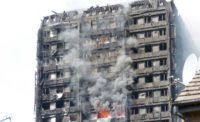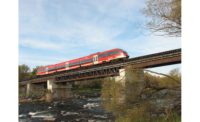The repercussions from the fire tragedy at Grenfell Tower, which killed 72 people in a London high-rise in June 2017, continue to spread through the world of building fire safety.
On July 18, the U.K. government expert panel that has been making suggestions on building safety measures expanded its previously issued advice regarding some classes of high-pressure laminate, or HPL.
Unlike the composite cladding panels used on Grenfell Tower—which consisted of a sandwich of aluminum composite material with a core that included polyethylene, a plastic—HPL involves a panel made with laminate created from paper fiber that may be impregnated with plastic resins. It is used on thousands of buildings in the U.K. and an unknown number in the U.S., often for decorative purposes such as trim on hotel balconies.
In an article published in the Journal of Hazardous Materials, a team of British researchers from the University of Lancaster tested the aluminum composite material panels used in Grenfell Tower, where a fast-moving fire raced up the exterior of the apartment tower. Composite sandwich panels with different types of plastic and non-plastic materials had been involved in a handful of other dramatic fires around the world.
The research team didn’t base its journal article research on tests of mock-ups or assemblies. Instead, the team studied the heat and calories resulting from the burning HPL panels using the oxygen-bomb test and a calorimeter. Those tests found that Grenfell-type panels showed 55 times greater peak heat release rates than the least flammable panels and 70 times greater total heat release.
Higher Overall Heat
The British team also compared Grenfell-type panels to those using HPL. While the HPL panels had somewhat lower peak heat release rates than the polyethylene-aluminum composites, Hull’s research found, the HPL panels gave off dramatically higher levels of heat overall.
The post-Grenfell aftermath has also brought questions about the usefulness of various types of fire tests. At least one U.K. scientist said the oxygen-bomb method was problematic because it does not represent a real-life simulation of how the materials might be used. Others, similarly, argued that tests of a particular cladding design’s final assembly are the best measure and source of information.
The UK expert panel said building owners should 'immediately take action' on the risky classes of HPL cladding panels.
Pushing back, the authors of the recently publish U.K. study contend that tests on large-scale mock-ups can be changed or manipulated until a passing result is achieved. The oxygen bomb method is also far less expensive.
In the weeks following the Grenfell Tower tragedy, the U.K. government banned the use of combustible materials in building external walls of 18 meters or more. The Communities Secretary also appointed an expert panel to advise on immediate measures related to fire safety. It is chaired by Sir Ken Knight, formerly London fire commissioner and U.K. chief fire and rescue adviser.
Unless a building whose panels have combustible materials completes the U.K.’s full assembly mock-up test and can be classified under the Building Research Establishment’s system, the expert committee suggested in December 2017, “the clearest way to ensure safety is to remove unsafe materials.” On July 18, the expert panel noted that although two classes of HPL panels are less risky than the risky class of aluminum composite panels, those HPL panels as well as those used with combustible insulation should be tested, classified or removed. Building owners should “immediately take action,” the expert panel stated.
The British research team estimated that HPL or other panel types with unsatisfactory fire properties are used in as many as 6,000 U.K. buildings, mostly as moisture barriers on multi-story residential buildings. The problem isn’t limited to the U.K., either. Two lecturers at Australia’s RMIT University in Melbourne recently noted in an article that policymakers in Australia “have yet to resolve the problem of combustible cladding” in that country. The estimated cost? Between $175 million and $1.1 billion.






Post a comment to this article
Report Abusive Comment